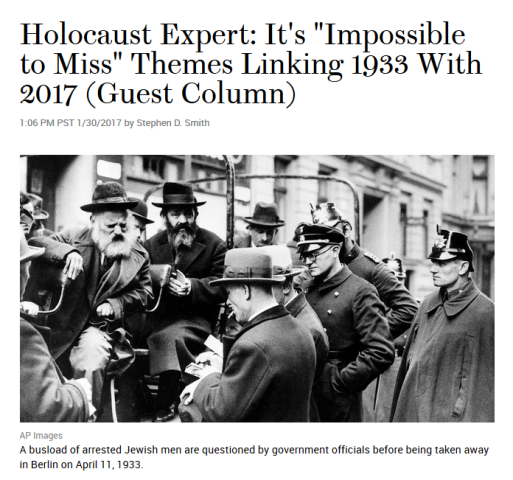It's "Impossible to Miss" Themes Linking 1933 With 2017
USC Shoah Foundation Executive Director Stephen Smith's column was originally published by The Hollywood Reporter.

Eleven weeks after Hitler became Chancellor (on April 7, 1933), the Nazis promulgated one of their first race laws, titled, “Law for Restoring the Professional Civil Service.” This was code for the expulsion of Jews from government agencies, such as courts of law and the teaching profession. That very first law contained a now-infamous Aryan Paragraph, a clause that identified who would be considered a Jew for the purpose of enforcement. The basis was not in fact race, but to quote, “when one of the parents or grandparents has belonged to the Jewish religion.”
The chaos that unfolded in 1933 was palpable. All Jewish workers in government institutions were fired, although exceptions were made for Jews who had long service or had fought “in the World War for the German Reich.” Over time the situation became even more confused as several new exemptions were issued, alongside tighter regulations, which for example extended the exclusions to those married to Jews.
The confusion was not only felt in the ever-changing scope of the orders, but also how authorities responsible for enforcement interpreted them. For example, Jewish veterans who had been exempted were told by enforcement officers that they were not able to sign as notaries, cutting their income in half. In what the authors of The Yellow Spot call a “cleansing culture,” once the Jews were identified as being a threat as an entire group, it became possible to cleanse members of that group from trade, law, medicine, science, literature, media, music, art and scholarship.
It is no accident that three U.N. conventions that deal with genocide (1948), human rights (1948), and refugees (1951) all emerged in the wake of World War II and the Holocaust. After the horrific outcome of Nazi policy against the Jews, at the heart of these conventions are protections for both individuals and groups irrespective of their background. History has demonstrated repeatedly that when a group is identified as a threat, indiscriminate actions can be taken without concern to the rights, values or contribution of individuals in that group.
The testimony of those who were there at the time is instructive. In 1933, Joe Dispeker was on a date with a German girl when a senior Nazi, Julius Streicher, arrived at the restaurant. One of his Brownshirts came over to ask whether Dispeker was Jewish. That soldier then asked his German date, who replied without hesitation that she was also. As the Nazis were more concerned about Jews defiling Germans at that point, they left the couple unharmed to dine. She may well have saved his life that night, as Joe decided in that moment to leave Germany.
Not everyone was so lucky. Giesella Feldman recalls being on the ill-fated St. Louis, a ship of Jewish refugees that was bound for Cuba in May 1939. Only 30 of the passengers were allowed to disembark in Cuba. Appeals then were made to President Roosevelt to allow the passengers to travel to America. But Secretary of State Cordell Hull advised against it, and the ship set sail back to Europe. The fate of all of its passengers is not known, although 234 are known to have perished in Nazi death camps. Feldman was among the 288 lucky passengers to have been sent to England.
No two circumstances in history are the same and seeking direct equivalence is misleading and dangerous. But the overarching themes linking 1933 and 2017 are impossible to miss. Identifying groups by religion is dangerous and divides society; denying refugees puts lives at risk and is against the values of Western civilization; standing up for neighbors and friends does work; if we play to our fears, everyone loses; one form of exclusion leads to another; courage costs nothing, weakness costs lives.
It was a hideous coincidence that the president of the United States announced measures to restrict entry to the United States to Muslims based on their religion, as well as refugees fleeing violent societies on Holocaust Memorial Day, a day established to remind us that lives matter, as do our values, our actions, and our voice in the World. During the Nazi period, Jews were not looking for other Jews to come to their assistance. They were looking more broadly for compassion, outrage and action, which never came, except in small acts of kindness. And the World remained silent. One of the victims of that silence was Holocaust survivor Paula Lebovics, who was liberated at Auschwitz 72 years ago. She reminded me this past weekend of the big picture: “Silence is not an option.”
Stephen D. Smith is executive director of USC Shoah Foundation, the archive of 54,000 testimonies of witnesses to the Holocaust and genocide. Its 100 Days to Inspire Respect program provides teachers with resources on discrimination and inclusion using testimony from its archive.